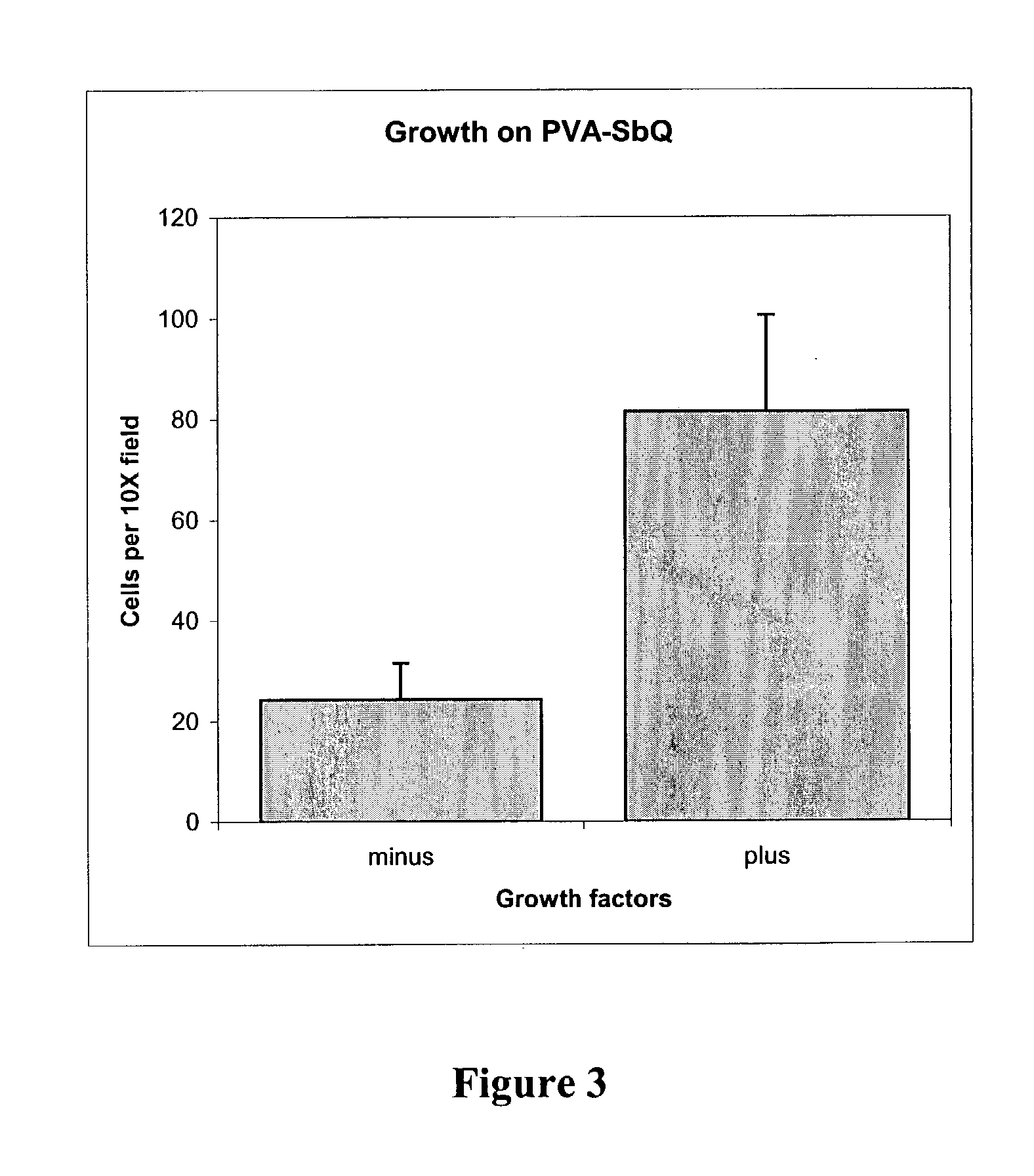PVA-based polymer coating for cell culture
- Summary
- Abstract
- Description
- Claims
- Application Information
AI Technical Summary
Benefits of technology
Problems solved by technology
Method used
Image
Examples
example 1
Making the Polymer Coating of the Present Invention without Bioaffecting Molecules
[0041] UV-cross-linkable PVA-SbQ was dissolved in water to make a solution of about 7% (w / v). 100 .mu.l of the solution was cast onto polystyrene petri dishes and spun at about 3000 rpm for 60 seconds so that a polymeric film having a thickness of about 1 micron was uniformly spread onto the polystyrene surface. The film was cross-linked under a 450 W UV light for 10 seconds.
example 2
Making the Polymer Coating of the Present Invention with Bioaffecting Molecules
[0042] Following the method of Example 1, platelet-derived growth factor-B (PDGF-B) (4 .mu.l of 200 .mu.g / ml solution) and insulin (10 .mu.l of 50 .mu.g / ml solution) were added to and dispersed in 2 ml of 7% PVA-SbQ solution. (The final concentrations of PDGF-B and insulin were 0.4 ng / ml and 250 ng / ml, respectively.) Then, the solution was cast on the bottom of petri dishes. A thin film of the polymer hydrogel was prepared on the bottom of the 60 mm diameter petri dish by spin-coating with 100 .mu.l PVA-SbQ solution containing growth factors at 3000 rpm for 60 seconds so that a polymeric film having a thickness of about 1 micron was uniformly spread onto the polystyrene surface. The films were cross-linked by UV irradiation for 10 minutes in a UV light box from 3D Systems (model PCA250, 10 UV bulbs, each 40 W at 420 nm).
example 3
Cell Culture Comparison on Uncoated Plates PVA Coated Uncross-linked Plates and PVA Coated Cross-linked Plates
[0043] Uncross-linked plates were prepared by spin-coating an aqueous solution of PVA (5% w / v) without the SbQ moiety onto 60 mm diameter petri dishes at 3000 rpm for 60 seconds. The plates were allowed to dry at room temperature.
[0044] Cross-linked plates were prepared by spin coating. Each petri dish (60 mm diameter) was coated with 100 .mu.l PVA-SbQ solution (5% w / v) at 3000 rpm for 60 seconds. The plates were allowed to dry at room temperature. The plates were cross-linked with UV light for 1 minute.
[0045] UV-cross-linked and uncross-linked PVA-based polymer coated plates were used for cell culture of human prostate tumor cell line PC-3 cells for 5 days. After 5 days, the plates were washed, fixed with formalin, and stained with haematoxylin and eosin.
[0046] As shown in FIG. 1, uncross-linked dishes (at the top) did not support cell adhesion. No staining was observed on ...
PUM
 Login to View More
Login to View More Abstract
Description
Claims
Application Information
 Login to View More
Login to View More - R&D
- Intellectual Property
- Life Sciences
- Materials
- Tech Scout
- Unparalleled Data Quality
- Higher Quality Content
- 60% Fewer Hallucinations
Browse by: Latest US Patents, China's latest patents, Technical Efficacy Thesaurus, Application Domain, Technology Topic, Popular Technical Reports.
© 2025 PatSnap. All rights reserved.Legal|Privacy policy|Modern Slavery Act Transparency Statement|Sitemap|About US| Contact US: help@patsnap.com



